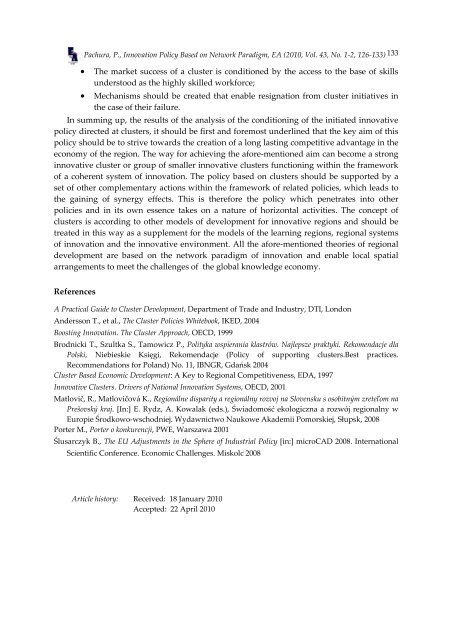Twice a Year Scientific Journal
Twice a Year Scientific Journal
Twice a Year Scientific Journal
You also want an ePaper? Increase the reach of your titles
YUMPU automatically turns print PDFs into web optimized ePapers that Google loves.
Pachura, P., Innovation Policy Based on Network Paradigm, EA (2010, Vol. 43, No. 1-2, 126-133) 133<br />
• The market success of a cluster is conditioned by the access to the base of skills<br />
understood as the highly skilled workforce;<br />
• Mechanisms should be created that enable resignation from cluster initiatives in<br />
the case of their failure.<br />
In summing up, the results of the analysis of the conditioning of the initiated innovative<br />
policy directed at clusters, it should be first and foremost underlined that the key aim of this<br />
policy should be to strive towards the creation of a long lasting competitive advantage in the<br />
economy of the region. The way for achieving the afore-mentioned aim can become a strong<br />
innovative cluster or group of smaller innovative clusters functioning within the framework<br />
of a coherent system of innovation. The policy based on clusters should be supported by a<br />
set of other complementary actions within the framework of related policies, which leads to<br />
the gaining of synergy effects. This is therefore the policy which penetrates into other<br />
policies and in its own essence takes on a nature of horizontal activities. The concept of<br />
clusters is according to other models of development for innovative regions and should be<br />
treated in this way as a supplement for the models of the learning regions, regional systems<br />
of innovation and the innovative environment. All the afore-mentioned theories of regional<br />
development are based on the network paradigm of innovation and enable local spatial<br />
arrangements to meet the challenges of the global knowledge economy.<br />
References<br />
A Practical Guide to Cluster Development, Department of Trade and Industry, DTI, London<br />
Andersson T., et al., The Cluster Policies Whitebook, IKED, 2004<br />
Boosting Innovation. The Cluster Approach, OECD, 1999<br />
Brodnicki T., Szultka S., Tamowicz P., Polityka wspierania klastrów. Najlepsze praktyki. Rekomendacje dla<br />
Polski, Niebieskie Księgi, Rekomendacje (Policy of supporting clusters.Best practices.<br />
Recommendations for Poland) No. 11, IBNGR, Gdańsk 2004<br />
Cluster Based Economic Development: A Key to Regional Competitiveness, EDA, 1997<br />
Innovative Clusters. Drivers of National Innovation Systems, OECD, 2001<br />
Matlovič, R., Matlovičová K., Regionálne disparity a regionálny rozvoj na Slovensku s osobitným zreteľom na<br />
Prešovský kraj. [In:] E. Rydz, A. Kowalak (eds.), Świadomość ekologiczna a rozwój regionalny w<br />
Europie Środkowo-wschodniej. Wydawnictwo Naukowe Akademii Pomorskiej, Słupsk, 2008<br />
Porter M., Porter o konkurencji, PWE, Warszawa 2001<br />
Ślusarczyk B., The EU Adjustments in the Sphere of Industrial Policy [in:] microCAD 2008. International<br />
<strong>Scientific</strong> Conference. Economic Challenges. Miskolc 2008<br />
Article history:<br />
Received: 18 January 2010<br />
Accepted: 22 April 2010
















